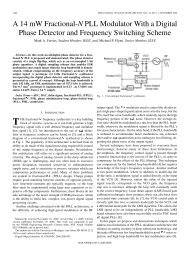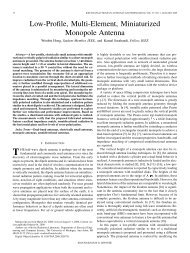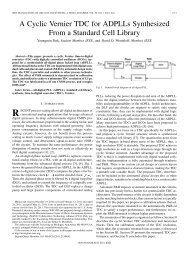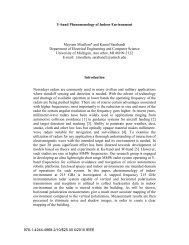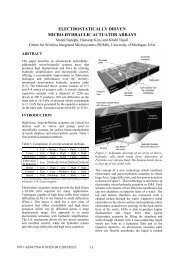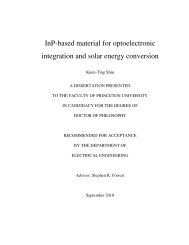Subwavelength Radio Repeater System Utilizing ... - IEEE Xplore
Subwavelength Radio Repeater System Utilizing ... - IEEE Xplore
Subwavelength Radio Repeater System Utilizing ... - IEEE Xplore
- No tags were found...
Create successful ePaper yourself
Turn your PDF publications into a flip-book with our unique Google optimized e-Paper software.
2686 <strong>IEEE</strong> TRANSACTIONS ON ANTENNAS AND PROPAGATION, VOL. 59, NO. 7, JULY 2011TABLE IIDESIGNED PARAMETERS OF CHANNEL ISOLATORFig. 5. Unit cell of channel isolator: (a) topology of unit cell; (b) square loopby image theory.frequency band (around 2.5 GHz). The artificial structure requireslarge physical dimensions, and the metamaterial insulatorcauses fabrication complexity and cost.To address these limitations, a metamaterial based channelisolator is proposed and designed as shown in Fig. 5(a). The proposedisolator is designed to resonate at the desired channel frequencyand decrease the mutual coupling by suppression of thesurface waves in the substrate generated by the vertical pins ofthe MMA. The vertical pins create a transverse magnetic (TM)wave in the substrate with zero cutoff frequency. The magneticfield is parallel to the ground plane and perpendicular to the pins.To inhibit propagation of the TM surface wave, an electromagneticband-gap (EBG) metamaterial layer can be utilized. Theadvantage of the band-gap material is that it creates an equivalentopen circuit to the surface wave as opposed to a short-circuitthat a metallic wall can produce.The band-gap metamaterial consists of an array of the parallelLC resonant circuits that are magnetically coupled with the substratemode. This is realized using unit cells that consist of verticalwires and horizontal conducting strips, which behave likea distributed inductor and a distributed capacitor, respectively.Using image theory, when each loop is imaged a larger loophaving a larger inductance and a smaller capacitance is formedas shown in Fig. 5(b). Assuming the fundamental mode propagatesfrom the TX to the RX through the substrate, the horizontallypolarized magnetic field linked by the square loop inducesan electric current on the vertical wires. In addition, this inducedcurrent generates a magnetic field which is perpendicular to theloop. When the unit cells are closely spaced to each other, theinductance of the loops is increased and the periodic array actslike a solenoid. At resonance the periodic layer acts as a perfectmagnetic conductor (PMC) plane. Due to the mutual couplingof the adjacent loops, the self inductance of the square loop asshown in Fig. 5(b) can be obtained from [14]where is the internal area of the loop and isthe periodicity of unit cells.The quality factor (Q) of the equivalent single pole isolatoraffects the performance and isolation bandwidth. Thus, commerciallumped capacitors with finite deviation of capacitance(1)values and low Q factor will cause the suppression of the mutualcoupling to deteriorate. To simultaneously reduce the deviationof these values, improve the Q factor, and lower the cost offabrication, printed circuit technology can be utilized to implementthe capacitors. As mentioned, the magnetic field inducesthe electric current on the vertical wires, and this current transformsto a displacement current (electric field) as it gets throughthe gaps between the fingers of the series interdigital capacitor.As most of the electric field between the metallic strips of thiscapacitor is in the gap and perpendicular to the metallic edges,its capacitance can be computed from the capacitance per unitlength of two thin co-planar strips given by [15]where is the metallization ratio and isthe complete elliptic integral of first kind defined bySince the individual capacitors between fingers are connectedin parallel, the total capacitance per unit length of interdigitalcapacitor is equal towhere is the capacitance between inner strips, is betweenouter and inner strips, and is the number of fingers. Hence,the total capacitance of the proposed isolator can be calculatedeasily from , where is the length of the fingers.The interdigital capacitor is centered between two verticalwires. The designed parameters are summarized in Table II. Thelength and height of the unit cell are chosen to be 6.25 mm1.57 mm. The corresponding inductance and capacitance of theunit cell are thus found to be 15.2132 nH and 0.1869 pF, respectively.Based on this calculation, the self resonant frequency iscalculated to be 2.98 GHz.III. PARAMETRIC STUDIES AND OPTIMIZATIONA. Optimal Configuration Without the IsolatorIn Section II, the principle of operation of the MMA was established.The modified MMA with two symmetric arms andvertical pins was designed on a small ground plane and was(2)(3)(4)(5)



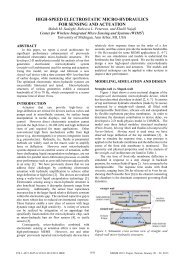
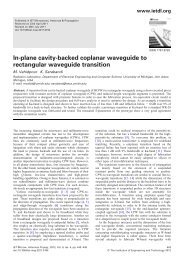
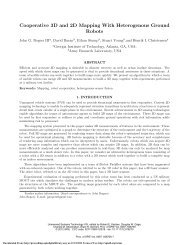
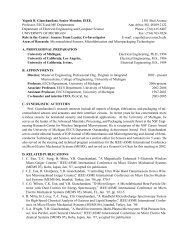
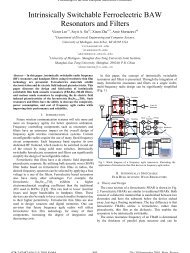
![[Sample B: Approval/Signature Sheet]](https://img.yumpu.com/34084789/1/190x245/sample-b-approval-signature-sheet.jpg?quality=85)
